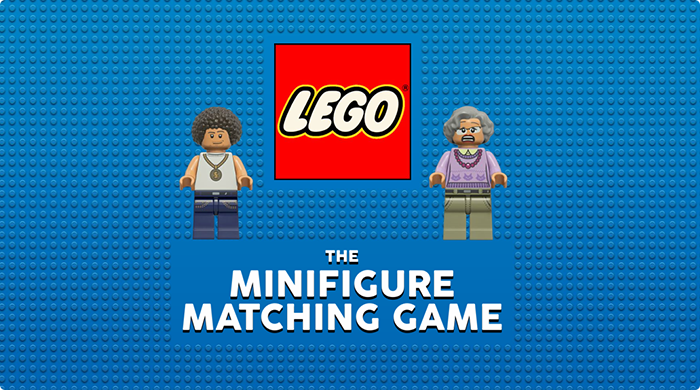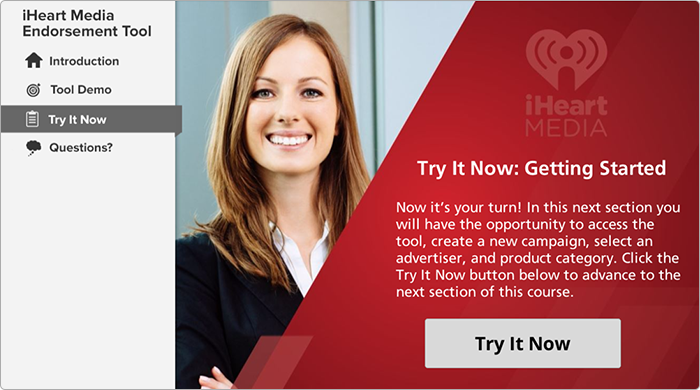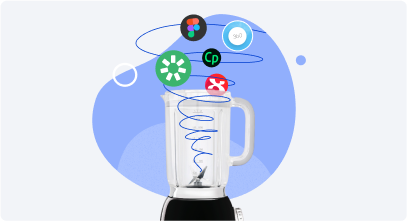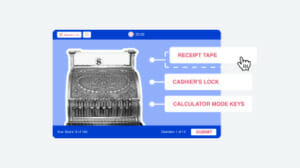How to Become an Instructional Designer: A Comprehensive Guide
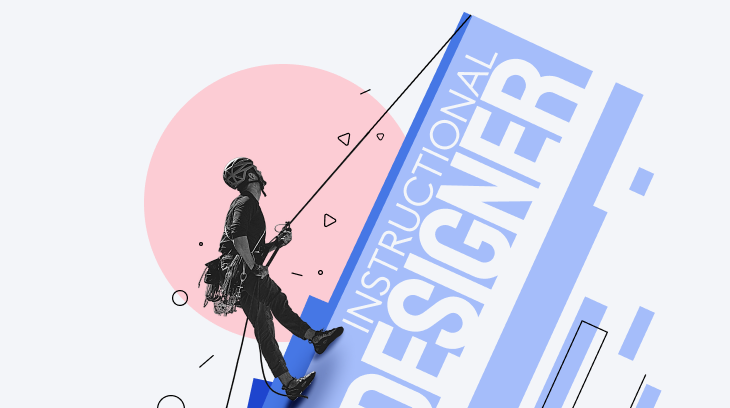
When you take an eLearning course or watch an instructional video, who do you think is behind it all? It might not be the coach you see on your screen. A great deal of the course development process rests on an instructional designer’s shoulders.
Going pro doesn’t happen overnight, but if you still have the passion and drive to study and practice, read our complete guide on how to become an instructional designer. We asked eLearning experts to share their insights to point you in the right direction.
Feel free to bookmark this article and come back for more insights. And make sure to download our Instructional Designer’s notebook, a collection of interactive guides, checklists, and tips on instructional design and eLearning.
Here’s an overview of what we’ll address in this article:
- What is an instructional designer?
- What instructional designers do
- The skills instructional designers should have
- How much an instructional designer gets paid
- How to get instructional design experience
- How to become an instructional designer
Create interactive online courses like a pro
Master every stage of interactive course development with 20 video lessons. Apply theory to practice with expert instructional designers.

What Is an Instructional Designer?
If you have friends outside of the eLearning world, they are likely to ask you what on earth an instructional designer is. Here is the answer you can give them: An instructional designer is an eLearning expert who gathers information from subject matter experts and uses instructional theories and models to create engaging and effective learning experiences.
Then your friends might say: “Okay, but what is it exactly that they do?”
What Instructional Designers Do
Instructional design is the art and science of creating learning experiences that help people gain the skills they need. The aim of the instructional designer is to identify knowledge and skill gaps, and find the most powerful ways to close them, whether through online courses, games, or training videos.
Instructional designers need to be experts in both how people learn and how to create content using technologies. They should be able to use authoring tools to create and deliver appealing learning materials and make training faster, easier, and more effective.
The roles and responsibilities of instructional designers are quite varied. They include:
- Defining clear learning objectives and creating compelling content that aligns with them.
- Interacting with subject matter experts (SMEs) to collect information based on the learners’ needs.
- Creating a detailed storyboard of how an e-course should look and which interactions it should include.
- Making online courses with an authoring tool for learning and skill building, and developing tests and assignments for performing knowledge checks and evaluating training effectiveness.
- Creating supporting materials that include multimedia, e.g., audio, video, screencasts, and gamification.
If you’re going to become an instructional designer, the specifics of your job will depend on at least these two factors:
- What field you’ll be working in (corporate, higher education, government, non-profit)
- Whether you will work full-time, part-time, or freelance
Let’s take a closer look at these factors.
Instructional design specifics in various fields
Nowadays, everyone needs online learning: small companies, large enterprises, universities, and nonprofits. These fields have both similarities and differences. Check out this table to get a general idea of the instructional design specifics for each one:
| Corporate | Higher education | Government | Nonprofit | |
| Who your learners will be | employees, partners, customers | students | government and military personnel | board members, staff, volunteers, donors |
| What eLearning content you will design | onboarding, compliance training, hard skills training, soft skills training, product knowledge training | mostly in-person courses converted to an online format, academic subject courses | orientation, hard and soft skills training, etc. | courses on fundraising, grant writing, and accounting, governance training, etc. |
| Average salary | $86,327 | $62,068 | $85,478 | $78,025 |
| Main advantage of working in the field | high salary | work-life balance | interesting projects that affect many people | challenging projects steered toward societal good |
| Main disadvantage of working in the field | possibility of overwork | limited career opportunities | bureaucracy and hierarchy | limited career opportunity |
Full-Time IDs vs. Freelance IDs
Apart from deciding what field you would like to work in, you should also determine how you would like to work. You can either be self-employed or work for a single company full-time (or part-time). Let’s see the specifics of these formats and their pros and cons.
Full-time instructional designer
A full-time job is something many instructional designers look for when they start out in the field. It may be comforting because you’re focused only on providing learning experiences for employees or students, and all other job-related duties lie in other departments.
However, you might find yourself quite limited in terms of choosing eLearning project topics, course development tools, and more.
Pros
- Stability
- Only instructional design duties
- eLearning tool expanses lie with the company
Cons
- Inexperienced beginners may receive a lower salary
- No opportunity to choose projects
- Strict working hours
Pros and cons of being a full-time instructional designer
Freelance instructional designer
A freelance instructional designer has more freedom in every respect: when and where to work, what projects to accept, which tools to use, and more. Still, any freelance job can be tricky. Although you have full control over your work and can take only the projects you’re excited about, it doesn’t necessarily happen like that – especially for beginners.
There just might not be enough interesting projects for you to earn a decent income from. So, you have to work on something less thrilling than you would prefer, and you have to perform the extra work of running your business (marketing, taxes, management, negotiations, etc.)
Pros
- Freedom of choosing projects, when and where to work, what tools to use, etc.
- Potentially higher income
- Independence
Cons
- Extra tasks
- Instability
Pros and cons of being a frelance instructional designer
The Skills Instructional Designers Should Have
Whether you aspire to be a full-time or freelance instructional designer, these are the essential skills you need to develop.
- Creative thinking. As an eLearning developer, it’s key to be able to think outside the box and come up with innovative solutions. This will help spice up the content to engage learners and make complex concepts easy to understand.
- Multimedia design skills. Being handy with multimedia tools and software, such as video editing, visual design, and audio production, really helps when creating captivating eLearning content.
- Project management. Instructional designers often find themselves handling multiple projects at once. So, having the ability to set deadlines, manage resources, coordinate with stakeholders, and keep everything running on time and within budget is crucial.
- Collaborative skills. eLearning designers frequently work with subject matter experts and other stakeholders. They need to communicate and collaborate with these individuals effectively to ensure that the learning materials meet the desired outcomes.
- Adaptability and a willingness to learn. The instructional design world is always evolving with new tools, technologies, and approaches constantly emerging. That means instructional designers have to be open to continuous learning and updating their skills to provide the best possible learning experiences.
To gain insight from other eLearning experts on the essential skills every instructional designer must have, read our article on the top 5 instructional designer skills.
How Much an Instructional Designer Gets Paid
According to Glassdoor, the average instructional designer salary in America is $71,070 per year. Devlin Peck, an eLearning expert, provides a different number – $85,466 per year. Of course, ‘average’ means you can earn both much more than and much less. There are 5 major factors that can affect your income:
1. Level of education
According to the survey conducted by Devlin Peck, eLearning specialists with a master’s degree get the highest salary: with a master’s degree, you’ll generally earn $2,000 more than you would with only a bachelor’s degree.
2. Geography
Instructional design incomes vary depending on what country you live in and work in. The highest average salaries are in America ($85,466) and Australia ($89,905), while the lowest are in the UK ($52,012) and India ($11,535).
3. Size of the organization
According to Glassdoor, an average instructional design salary in small companies is $69,750 and $75,024 in large enterprises.
4. Instructional design field
The field you work in has a great influence on how much you get paid. Take a look at Devlin Peck’s data on average salaries in instructional design fields:
- Corporate: $86,327
- Government: $85,478
- Nonprofit: $78,025
- Higher education: $62,068
5. Professional experience
Glassdoor states that the average salary of an instructional designer with 0-3 years of experience is $63,653, while the wage for those with over 15 years is $84,528. According to Devlin Peck, IDs with 0-3 years of professional experience receive the lowest salary of $71,961, and those with 16-20 years receive the highest average salary of $110,737.
How to Get Instructional Design Experience
Professional experience can be an essential factor during your job interview. You might even get the position without it, but this would definitely have an impact on your salary. So, how can you get course development experience? There are at least 3 ways to do this:
University projects
If you’re getting a master’s degree in instructional design, you have plenty of opportunities to get your first professional experience. You’ll be involved in different eLearning projects for organizations, and your final project is likely to be a course on some topic.
Volunteering
If you’re currently working in a different field, you can volunteer at your workplace to create an eLearning project. That way, you’ll be creating a course about something you know about – which is great – and you’ll get a chance to check whether instructional design is right for you.
Networking and consulting
Find other instructional designers on LinkedIn and follow them. They might post job vacancies from time to time. Or, you could participate in an eLearning project as a consultant. Besides, networking is a crucial part of the eLearning world, so you might want to start doing that right away.
How to Become an Instructional Designer
There are 4 main paths to instructional design: the direct path, transitioning from teaching, transitioning from a position as a school administrator, and getting there from a noneducational sphere. Let’s look at each of them:
Direct path
The direct path is for people who want to get into the eLearning world right after they graduate from university. If you’re currently finishing your bachelor’s degree and thinking about getting a master’s in instructional design, check out the best academic courses listed later in the article.
What’s important to keep in mind is that, unlike teachers, school administrators, and other professionals, you don’t have any professional experience yet. So, it would be great if you could get that while attending university.
Transitioning from teaching
Teachers and university professors have lots of teaching experience, know teaching models, strategies, and much more. But this could be both a great advantage and a limitation. You see, instructional design differs from traditional teaching. You have different learners, different tools, different models, and your role is different too. It’s important that you realize this, acquire new knowledge and skills, and adapt your previous experience and knowledge to your new profession.
Download our comprehensive journey map “Transitioning from Teaching to Instructional Design.” It includes everything you need to start out in your new career: all the basic instructional design theories and models, practical guides, checklists, ID volunteer opportunities, job interview questions, and much more!
Transitioning from a role as a school administrator
School administration might be a great background for instructional design – especially if you’re looking for freelance work. You already have the necessary organizational skills, such as learner management or curriculum design, that some eLearning specialists might find complicated. However, to create online courses, you’ll need to study instructional design theory and upgrade your design skills.
From a noneducational sphere
The fact that you don’t have any prior teaching experience might be your advantage. First of all, you will not mix teaching knowledge and skills up with those of instructional design – you’re like a blank page, and you can fill yourself only with relevant information.
Also, you are likely to have worked somewhere, which makes you an expert in that particular field. So, you can become an instructional designer who specializes in that sphere. Let’s suppose you used to build cars. Imagine how preferable you would look among other learning designers who don’t have such experience and apply for an ID job at Mercedes or Volkswagen. Study ID theory, practice, network, and you’ll be great.
No matter which path you take, following these steps will be of great help If you want to know how to become an instructional designer:
Step 1: Study ID Models, Theories, and Strategies
Let’s say you’ve realized that your dream is to become an instructional designer and you want to make it come true as quickly as possible. The first thing you need to do is learn the basics of eLearning, study instructional design models, theories, and strategies, and get certifications to prove your competence. There are two basic ways to do that: university programs and nonacademic courses.
The best instructional design university programs
Check out these five university programs. All of them are focused on innovative eLearning approaches and modern technologies, methods, and techniques.
- Indiana University Bloomington: Instructional Systems Technology
- Florida State University: Instructional Systems and Learning Technologies
- University of Georgia: Educational Psychology
- Purdue University: Learning Design and Technology
- Michigan State University: Educational Psychology and Technology
The best instructional design courses
If you don’t feel like taking a full-fledged master’s program, you can take an online course. We’ve collected five great instructional design courses for you to check out. If you want to learn more about each of them and see some other courses, check our article.
- IDOL Courses (Instructional Design Academy)
- Instructional Design Certificate – 4 courses (University of Wisconsin-Stout)
- Learning Design and Technology Graduate Certificate (Harvard Extension School)
- MicroMasters Program in Instructional Design and Technology (University of Maryland)
- Learning to Teach Online (Coursera)
Instructional design models
For those who want to study instructional design theory on their own, we’ve prepared the basic info on various ID models. Check them out:
ADDIE Model
The first handy design tool you should have in your eLearning arsenal is the ADDIE framework.
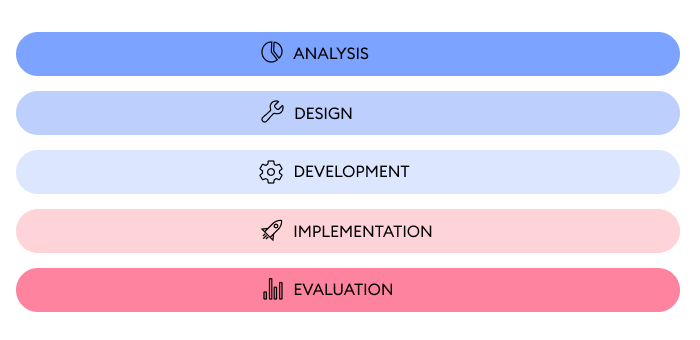
The ADDIE Model
The ADDIE model has been around since the 70s and tackles the five stages each eLearning project goes through (which gives rise to the acronym). They are:
- Analysis. In the analysis phase, you need to clarify at least two things. Who is your target audience, and what should they know or be able to do after completing the course?
- Design. Now that it’s clear who you’ll train and what knowledge they should get, you need to understand how. Which instructional methods, activities, textual content, and media assets will you use to create a killer learning experience?
- Development. Now it’s time to translate all this into reality. You need to storyboard the text, produce graphics and videos, and develop the learning interactions outlined in the design stage. Then, gather all the content and start building a course. This can be a challenging and time-consuming phase, but authoring tools can make your job quicker and easier.
- Implementation. This is the phase where the course goes live. Since it’s ready now, share it with your learners. For example, you can deliver a course right to the LMS that they use.
- Evaluation. Since evaluation can help make training even better, it’s crucial to gather learners’ feedback. You need to find out what works, and what should be improved.
Make sure to read about the ADDIE model in more detail.
SAM (Successive Approximations Model)
The SAM model is a more recent instructional design model, created by eLearning pioneer Michael Allen. It’s built to help you design meaningful, memorable, and motivational learning experiences.
The SAM model is an alternative to the ADDIE model and aims to fix some limitations of its predecessor. The main difference is probably that, with the SAM model, there’s more creativity and freedom in the project creation process, while ADDIE has a strict structure that makes you follow each step. Here’s how you’ll create your eLearning project if you choose SAM:
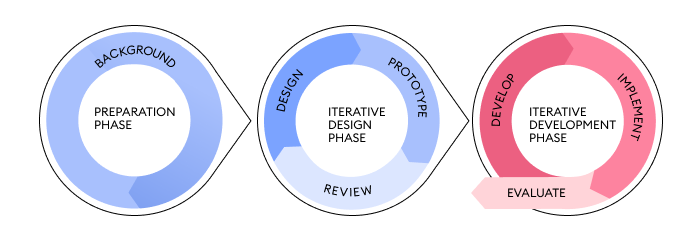
SAM (Successive Approximations Model)
- Preparation Phase
Collect background information on learners’ prior knowledge, weaknesses, strengths, and other factors. Brainstorm ideas on every aspect of your project. By the end of this phase, you are to come up with a potential design for every content area.
- Iterative Design Phase
Design and prototype your project and send it to other people for review. Based on the feedback, fix the weaknesses.
- Iterative Development Phase
Finish your online course and implement it. Collect feedback from your learners, evaluate the training program, and fix issues if necessary by returning to the iterative design phase.
Gagné’s Nine Events of Instruction
Gagné’s Nine Events of Instruction, when used together, form a framework for a successful learning process. The idea is that once you complete each step, your learners are likely to be more engaged in learning and subsequently retain new knowledge and skills. Consider these events when designing an eLearning course:
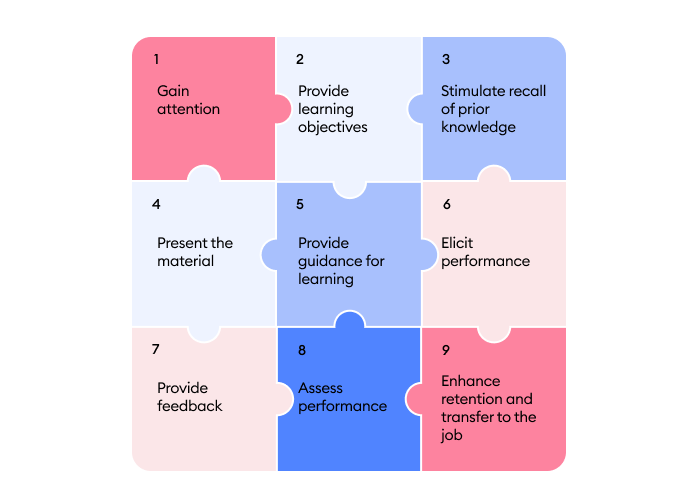
Gagné’s Nine Events of Instruction
Kirkpatrick’s Four-Level Training Evaluation Model
Don Kirkpatrick suggests 4 levels of training evaluation: Reaction, Learning, Impact, and Results.
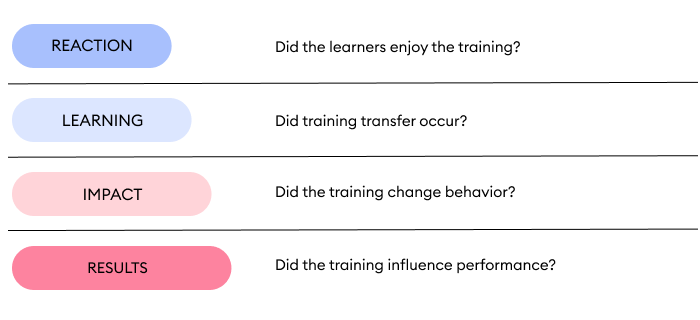
Kirkpatrick’s Four-Level Training Evaluation Model
Here’s what to do if you decide to evaluate your course with this model:
Level 1: Reaction
Collect learners’ feedback on the course.
Level 2: Learning
Measure how much new knowledge learners gained from your course.
Level 3: Impact
Assess how much an employee’s behavior changed after the training program.
Level 4: Results
Analyze quality, efficiency, productivity, and customer satisfaction ratings to evaluate the overall impact of your course on the organization.
Make sure to learn about this and other training evaluation models.
The Revised Bloom’s Taxonomy
The original Bloom’s taxonomy included these 6 categories:
- Knowledge
- Comprehension
- Application
- Analysis
- Synthesis
- Evaluation
However, in 2001, a group of cognitive psychologists and education specialists offered a revision of this taxonomy that proved to be more effective. Instead of nouns used by Benjamin Bloom, they used action words – verbs and gerunds – that describe the learner’s cognitive processes. They also changed the sequence and replaced the “Synthesis” category with the “Create” step. Check it out:
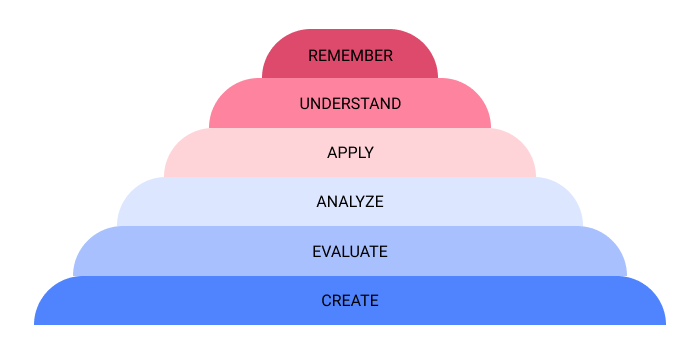
The Revised Bloom’s Taxonomy
1. Remember
Recall facts and basic concepts.
Define, duplicate, list, memorize, repeat, state.
2. Understand
Explain ideas or concepts.
Describe, discuss, explain, identify, locate, recognize, report, select, translate.
3. Apply
Use information in new situations.
Execute, implement, solve, use, demonstrate, interpret, operate, schedule, sketch.
4. Analyze
Establish connections among ideas.
Differentiate, organize, relate, compare, contrast, distinguish, examine, experiment, question, test.
5. Evaluate
Justify a stand or decision.
Appraise, argue, defend, judge, select, support, value, critique, weigh.
6. Create
Produce original work.
Design, assemble, construct, conjecture, develop, formulate, author.
Waterfall Model
The Waterfall model is a sequential linear adaptation of the ADDIE model that includes these 6 steps: feasibility, analysis, design, implementation, testing, and maintenance.
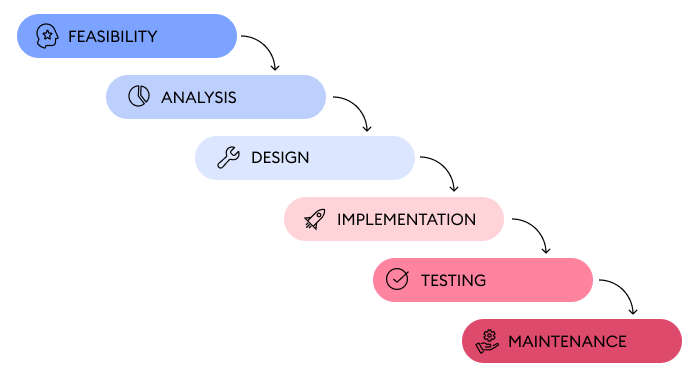
The Waterfall Model
The model is based on the idea that each following step is easier than the previous one, as is the case with a waterfall: water falls faster and faster until it hits the ground. The course development happens quickly because once you finish a step, you don’t come back to it, so you don’t spend extra time running through content, visuals, and other project components. However, this might affect the overall course quality.
Merrill’s Principles of Instruction
David Merrill suggested 5 instructional design principles that will help you create a truly effective learning experience:
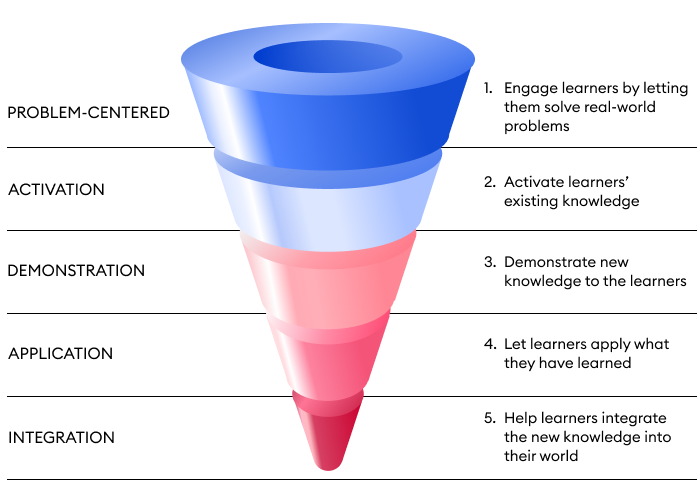
Merrill’s Principles of Instruction
Principle 1: Problem-Centered
Engage learners by letting them solve real-world problems:
- Show an example of the task that learners will perform.
- Make sure learners understand what they are going to do and are interested in the task.
- Provide learners with a basic problem, then give them a complex real-life problem to solve.
Principle 2: Activation
Activate learners’ existing knowledge and use it as a foundation for new knowledge. Ask them about their relevant experience and knowledge, and make up examples and tasks that connect both with these experiences and new information.
Principle 3: Demonstration
Learners need to see everything: learning outcomes, new knowledge application examples, etc. Your task is to show it to them using media that will engage them.
Principle 4: Application
Let learners apply what they’ve learned. Provide them with guidance on how to use new knowledge and skills, and give them an opportunity to practice them.
Principle 5: Integration
Help learners integrate new knowledge into their world. In order to do this, let them demonstrate new skills to others, reflect on them, and encourage learners to transfer what they have learned into their lives.
AGILE
AGILE is another course development model that focuses on one eLearning module at a time. You move to the next one only after you’ve finished the previous one. This results in a higher quality course because you pay more attention to details in each segment.
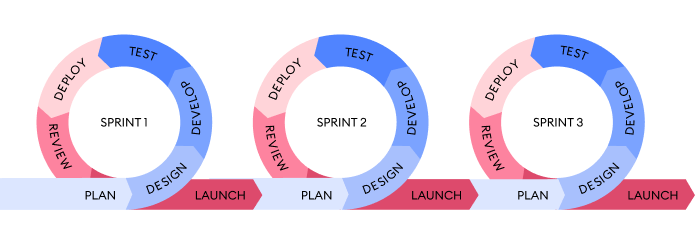
The AGILE model
So, here’s what you should do according to the AGILE model:
Align
Set goals and objectives.
Get Set
Plan how you are going to develop your eLearning project.
Iterate and implement
Develop the project following the plan.
Deploy
Test the module.
Evaluate
Collect feedback, analyze, and assess the module. Fix any issues.
Instructional design essentials
If you want to deliver good knowledge and skills, and keep your learners engaged and motivated, you need to understand them. Realize how they absorb the information, what drives them to better learning results, and, conversely, what can be a distraction.
If you’re going to promote training in the workplace, start exploring the psychology and behaviors of the average adult learner. Of course, there’s no single learning approach that works for everyone, though there are some generic aspects common to all people that you should know about:
- Adult learners have a wealth of experience to draw on when learning and they want their voices heard.
- They learn best when there are opportunities to self-reflect and internalize the learning.
- They aren’t used to receiving direction in education and want to be respected for their experience. Ideally, they want to contribute their experience and wisdom when in a learning environment, rather than just absorbing content.
- Adult learners need a purpose or motivation for learning. It might be that learning a framework can make a process more efficient and/or the learning might help them achieve goals – ranging from realizing personal achievements to improving in their current role, or even preparing for a new role.
- They want their ideas and learning needs to be incorporated into the process; they want to be involved.
- Many adult learners are self-directed, meaning they like to learn independently in a self-paced environment.
- They don’t have a lot of extra time in their day or life for learning and prefer chunks/bursts of learning (microlearning) and individualized training. They are more motivated to learn if they have quick wins by completing learning rapidly.
To delve deeper into how adults learn, you can also explore existing adult learning theories, including Transformational, Experiential, and Individualized (Centric) learning, as well as Andragogy.
Step 2. Learn the Basics of Visual Design
The way that content is displayed affects how people perceive it. Visual design isn’t just about making things look nice. When done correctly, it helps make content easier to consume and saves learners’ minds from cognitive overload.
You might argue that visuals don’t matter in eLearning. But let’s be realistic, the four basic principles of visual design, such as contrast, proximity, repetition, and alignment, are hard to argue against.
Let’s take a closer look at each principle:
- Contrast: Contrast is all about making things stand out by using different colors, sizes, or typography. It helps highlight important information, draws attention to key concepts, and makes content more visually appealing. For example, using different colors for headers and body text makes things easier to read and helps learners distinguish between different sections of content.
- Proximity: Proximity is when you group related elements together to show they’re connected. By putting similar things close to each other, you let learners know that they’re related and organized. For example, grouping together images, text, and icons helps learners see how different parts of a concept or topic fit together.
- Repetition: Repetition means using the same visual elements, like colors, fonts, or styles, throughout your materials. By repeating certain design elements, you can provide a cohesive visual experience for learners. This helps reinforce learning by establishing patterns that learners can recognize and associate with specific information.
- Alignment: Alignment is about arranging visual elements in relation to each other. Proper alignment creates a sense of order and structure in training materials, making them more visually pleasing and easier to read. You should align text, images, and other elements in a way that ensures their visual harmony and promotes a more fluid navigation. Well-aligned content enables learners to engage with the material more effectively and avoids distracting or confusing visual clutter.
This was just a brief introduction to visual design. To delve deeper into this topic, check out our article on the basic principles of graphic design.
Step 3. Choose the eLearning Tool for the Current and Specific Use
So, now you’ve got the necessary theoretical ID background. If you’re hoping to move further toward a career as an instructional designer, you need to gain some technical skills. You can start by studying our list of 50+ tools for instructional designers. Of course, you might not need them all, but you’ll be able to choose one or more tools for your current tasks.
For example, you might try iSpring Suite. This is an authoring toolkit that allows you to build interactive courses containing different types of eLearning content quickly and easily. You can enhance slides with tests and drag-and-drop activities, add video and audio narrations, build realistic dialogue simulations, and record and fine-tune screencasts and training videos with the integrated video studio.
Experience this eLearning demo to see what a course created with iSpring Suite looks like:
If this kind of content is exactly what you need, our guide on how to create online eLearning courses and Michael Sheyahshe’s webinars will walk you through the whole process.
Still not sure? Explore some other amazing courses made with iSpring Suite or download a free 14-day trial and test drive all the features right now.
Step 4. Make eLearning Samples and Create an ID Portfolio
The next important step you need to take is to start practicing. Armed with all the necessary theoretical knowledge and an authoring tool, you can start creating sample e-courses. And why not present some of your samples in your resume?
Having a good ID portfolio is the quickest way to get the job you’re dreaming about. It’ll provide your potential employers with an overview of your skills, educational background, creative abilities, and subject matter expertise. Check out some tips from Christy Tucker, Learning Experience Design Consultant and the owner of Syniad Learning, LLC:
Tips for making eLearning samples
- Make it short. Most prospective employers won’t sit through a 30-minute module. Just include an interesting snippet that can be reviewed in under 5 minutes. A sample might be just a few slides, or even a single interaction that shows off your skills.
- Pick a topic you know or can research online. Topics like time management, handling customer objections, or software demos don’t require much specialized knowledge. Topics related to workplace training are more effective as portfolio samples than overly simple topics like “how to make a sandwich.”
- Don’t focus only on visuals and interactions. Think about the learning objectives and show off your instructional design skills, not just flashy development skills.
Tips for creating an instructional design portfolio
- Include eLearning samples with descriptions. Describe your process and explain why you chose that approach.
- Focus on what you want to do. For example, if you love creating software training, include software simulations and quick reference guides.
- Mention only relevant information. If you can’t stand working with a particular tool, don’t include those samples in your portfolio. Also, those who want to develop in workplace training should avoid examples aimed at children and add samples that are relevant for adults.
- Create your personal website. Of course, you can use various portfolio website builders, but, in my experience, the ideal solution is a personal website with a custom domain. When you own your own site, you have control over everything: how it looks and what you include.
Check out our step-by-step guide on building an instructional design portfolio. And take a look at these portfolio examples to get ideas on how to create your own personal portfolio.
Step 5. Learn from Other Instructional Designers’ Experiences
Another vastly important piece of this puzzle is the human element. To become a good instructional designer and develop in your profession continuously, you need to learn from those who walked a similar path and came out on top. There are 3 principal ways to do this:
- Read instructional design books
- Watch instructional design videos
- Follow instructional design blogs and websites
We’ve compiled the top lists for each of these resources. They all give insights on how to create better learning experiences, use authoring tools, and manage eLearning projects. Check them out!
Step 6: Prepare for the Job Interview
At some point, you’ll need to go to a job interview, where a hiring manager will decide whether you’re the right fit based on your answers. So, you’ll need to be prepared. Here’s what a hiring manager needs to know about you:
- If you know instructional design theories, models, and strategies, and can apply them
- What work experience you have (if any)
- What tools you can use
- How well you understand the specifics of the company and its learning needs
- If you’re a pleasant person to work with (your communication skills, interpersonal skills, and overall EQ – level of emotional intelligence)
If you want to learn more, read our article on 11 instructional design interview questions and how to answer them.
Step 7. Keep apace with Instructional Design and eLearning Trends
An instructional designer should always stay up to date with two things: trends in instructional design and trends in eLearning technology. In fact, it’s hard to separate them, since they are interdependent. However, the first is more about popular approaches to ID like video-based learning or mobile learning, while the second is focused on emergent technologies like virtual reality and artificial intelligence.
When keeping updated on ID and eLearning trends, you may look into new areas and skills that you want to upgrade and find new ways to make learning experiences even better.

Jeff Dalto, Senior L&D Specialist at Convergence Training
There are four sources of “trendy” knowledge you shouldn’t ignore:
- The simplest thing you can do is to find experts in the field in social media, including LinkedIn and Twitter, and keep up with what they’re posting about.
- Join professional organizations such as ATD and eLearning Guild. Follow them on social media and read their websites.
- Attend conferences in the eLearning and training industry, where you can meet other professionals. Watch their informational presentations and see their product demos.
- Create a “community of practice” with like-minded coworkers or eLearning professionals in your area. Have regular meetings or webinars to discuss ideas, books, trends, and new products, and help one another keep abreast of what’s what.
You may try all this, but you need to be wary of marketing hype and the seductive qualities of the latest new things. There are a lot of unfounded learning myths out there already, and excitement over the newest trend has a tendency to add to that.
So be open-minded to new trends, but also be skeptical; make sure the claims line up with what you know about how people learn and look for supporting data. Learning researchers like Dr. Will Thalheimer (and others) are great at helping you separate what’s real from what’s snake oil in the learning profession.
Frequently Asked Questions
Here are some important questions that instructional designers might need answers to:
1. Do I need a master’s degree to work as an instructional designer?
A master’s degree can be beneficial if you’d like to land a job in a governmental or academic institution. However, it’s typically not necessary for most corporate roles. Instead, focusing on building a strong portfolio that showcases your abilities will greatly enhance your chances for success.
2. How can I land an instructional design job with no experience?
You can build a portfolio to showcase your skills, and network with professionals in the industry to increase your chances of landing a job. Additionally, consider volunteering for local non-profits to gain practical experience or offering to design learning programs for your current employer.
3. Is instructional design a promising profession?
Definitely. The demand for instructional designers is increasing as more organizations recognize the importance of quality training and development programs. Furthermore, advancements in technology and the integration of interactive learning methods make this a field that is continuously evolving and full of opportunities.
A career in instructional design is exciting, but beginnings can be difficult and confusing. We hope our guide on how to become an instructional designer will help you start your career and move toward the top of your field, step by step. Remember to download our Instructional Designer’s notebook, a collection of interactive guides, checklists, and tips you’ll need in your new profession.
Good luck!
Takeaways
- Learning about different ID models and strategies will serve as the backbone of your online courses and will help you create engaging content.
- Studying the psychology and behaviors of the adult learner and exploring learning theories will help you provide your audience with the most meaningful and memorable eLearning experiences.
- Knowing the basics of visual design will let you create visually appealing content, make content easier to consume, and reduce cognitive overload.
- Along with a theoretical ID background, you need to gain some technical skills and choose eLearning tools that meet your requirements.
- Your ID portfolio should ideally be focused on the particular kind of work you want to do, and include eLearning samples with descriptions.
- Following some of the top instructional designers’ blogs is an effective way to expand your knowledge of ID.
- When keeping up with ID and eLearning trends, look into new areas and skills that you want to upgrade and find new ways to make learning experiences even better.



